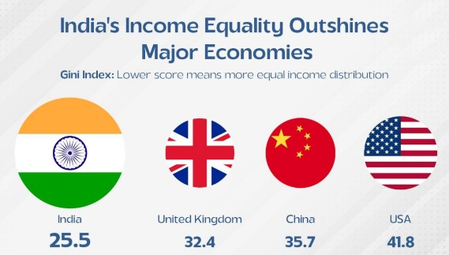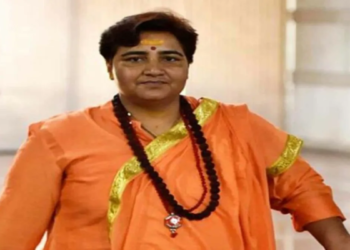New Delhi, 5 July (IANS). According to a World Bank report, as another important achievement for the government led by Prime Minister Narendra Modi, India’s Guinea Index has now reached 25.5, which makes it the fourth most similar country in the world after the Slovak Republic, Slovenia and Belarus.
The guinea index is a simple but powerful way of understanding how income, property or consumption in a country is distributed equally in homes or individuals.
Its value ranges from 0 to 100. 0 The score reflects complete equality, while 100 scores means that a person has all income, property or consumption and others have nothing, so have complete inequality. The higher the guinea index, the more uneven the country will be.
India score is less than China’s 35.7 and the United States 41.8. It is more similar than every G7 and G20 country, many of which are considered advanced economies.
India is not only the fourth largest economy in the world; Rather it is one of the most similar societies today. This is a major achievement for a country with its shape and variety.
This shows how India’s economic progress is being shared equally in its population.
This success behind this success is to focus policy focus on reducing poverty, expanding financial access and providing direct welfare to the most needy people.
According to the government, India’s strong position on the Guinea index is no coincidence.
According to an official statement, “It is closely associated with the continuous success of the country in reducing poverty in both rural and urban areas. Spring 2025 poverty and equality by the World Bank have highlighted this achievement as one of the most important in recent years.”
According to the World Bank report, 17.1 crore Indians have been taken out of excessive poverty in the last decade.
By June 2025, the global limit for excessive poverty was reduced from 16.2 percent to just 2.3 percent in 2022-23 in 2011-12 at $ 2.15 per day.
The World Bank’s revised excessive poverty limit $ 3.00 per day, the poverty rate of 2022-23 will be adjusted at 5.3 percent.
India’s progress in the direction of high income equality is supported by many concentrated government initiatives.
Some major schemes and initiatives include PM Jan Dhan Yojana, Aadhaar and Digital Identification, Direct Benefit Transfer (DBT), Ayushman Bharat, Stand-Up India, Pradhan Mantri Garib Kalyan Yojana (PMGKAY) and PM Vishwakarma Yojana.
The central government said, “The ability to balance between economic reforms and strong social security makes India different. Tarfed schemes like Jan Dhan, DBT and Ayushman Bharat have helped to remove long-running deficiencies. Also, programs like Stand-up India and PM Vishwakarma Yojana are helping people to earn money and secure livelihood on their terms.”
-IANS
SKT/










